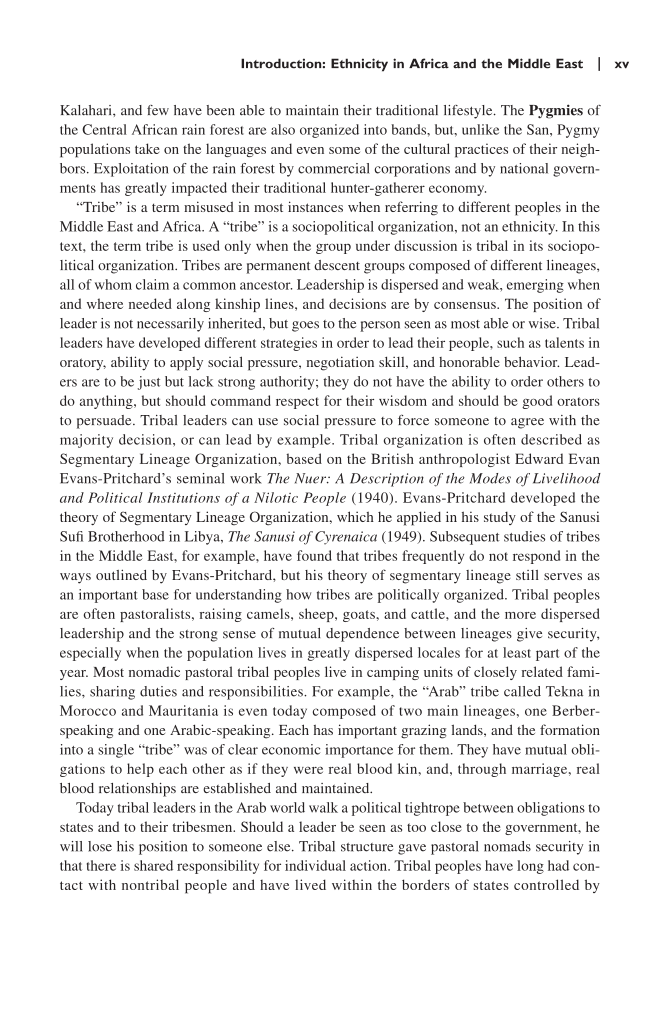Kalahari, and few have been able to maintain their traditional lifestyle. The Pygmies of the Central African rain forest are also organized into bands, but, unlike the San, Pygmy populations take on the languages and even some of the cultural practices of their neigh- bors. Exploitation of the rain forest by commercial corporations and by national govern- ments has greatly impacted their traditional hunter-gatherer economy. “Tribe” is a term misused in most instances when referring to different peoples in the Middle East and Africa. A “tribe” is a sociopolitical organization, not an ethnicity. In this text, the term tribe is used only when the group under discussion is tribal in its sociopo- litical organization. Tribes are permanent descent groups composed of different lineages, all of whom claim a common ancestor. Leadership is dispersed and weak, emerging when and where needed along kinship lines, and decisions are by consensus. The position of leader is not necessarily inherited, but goes to the person seen as most able or wise. Tribal leaders have developed different strategies in order to lead their people, such as talents in oratory, ability to apply social pressure, negotiation skill, and honorable behavior. Lead- ers are to be just but lack strong authority they do not have the ability to order others to do anything, but should command respect for their wisdom and should be good orators to persuade. Tribal leaders can use social pressure to force someone to agree with the majority decision, or can lead by example. Tribal organization is often described as Segmentary Lineage Organization, based on the British anthropologist Edward Evan Evans-Pritchard’s seminal work The Nuer: A Description of the Modes of Livelihood and Political Institutions of a Nilotic People (1940). Evans-Pritchard developed the theory of Segmentary Lineage Organization, which he applied in his study of the Sanusi Sufi Brotherhood in Libya, The Sanusi of Cyrenaica (1949). Subsequent studies of tribes in the Middle East, for example, have found that tribes frequently do not respond in the ways outlined by Evans-Pritchard, but his theory of segmentary lineage still serves as an important base for understanding how tribes are politically organized. Tribal peoples are often pastoralists, raising camels, sheep, goats, and cattle, and the more dispersed leadership and the strong sense of mutual dependence between lineages give security, especially when the population lives in greatly dispersed locales for at least part of the year. Most nomadic pastoral tribal peoples live in camping units of closely related fami- lies, sharing duties and responsibilities. For example, the “Arab” tribe called Tekna in Morocco and Mauritania is even today composed of two main lineages, one Berber- speaking and one Arabic-speaking. Each has important grazing lands, and the formation into a single “tribe” was of clear economic importance for them. They have mutual obli- gations to help each other as if they were real blood kin, and, through marriage, real blood relationships are established and maintained. Today tribal leaders in the Arab world walk a political tightrope between obligations to states and to their tribesmen. Should a leader be seen as too close to the government, he will lose his position to someone else. Tribal structure gave pastoral nomads security in that there is shared responsibility for individual action. Tribal peoples have long had con- tact with nontribal people and have lived within the borders of states controlled by Introduction: Ethnicity in Africa and the Middle East xv
Document Details My Account Print multiple pages
Print
You have printed 0 times in the last 24 hours.
Your print count will reset on at .
You may print 0 more time(s) before then.
You may print a maximum of 0 pages at a time.

























































































































































































































































































































































































































